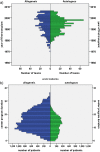Economics and Outcome After Hematopoietic Stem Cell Transplantation: A Retrospective Cohort Study
- PMID: 26844291
- PMCID: PMC4703735
- DOI: 10.1016/j.ebiom.2015.11.021
Economics and Outcome After Hematopoietic Stem Cell Transplantation: A Retrospective Cohort Study
Abstract
Hematopoietic stem cell transplantation (HSCT) is a lifesaving expensive medical procedure. Hence, more transplants are performed in more affluent countries. The impact of economic factors on patient outcome is less defined. We analyzed retrospectively a defined cohort of 102,549 patients treated with an allogeneic (N = 37,542; 37%) or autologous (N = 65,007; 63%) HSCT. They were transplanted by one of 404 HSCT centers in 25 European countries between 1999 and 2006. We searched for associations between center-specific microeconomic or country-specific macroeconomic factors and outcome. Center patient-volume and center program-duration were significantly and systematically associated with improved survival after allogeneic HSCT (HR 0·87; 0·84-0·91 per 10 patients; p < 0·0001; HR 0·90;0·85-0·90 per 10 years; p < 0·001) and autologous HSCT (HR 0·91;0·87-0·96 per 10 patients; p < 0·001; HR 0·93;0·87-0·99 per 10 years; p = 0·02). The product of Health Care Expenditures by Gross National Income/capita was significantly associated in multivariate analysis with all endpoints (R(2) = 18%; for relapse free survival) after allogeneic HSCT. Data indicate that country- and center-specific economic factors are associated with distinct, significant, systematic, and clinically relevant effects on survival after HSCT. They impact on center expertise in long-term disease and complication management. It is likely that these findings apply to other forms of complex treatments.
Keywords: Center effect; GNI/cap; HCE/cap; HDI; Hematopoietic stem cell transplantation; Macroeconomics; Microeconomics; Outcome; Patient volume; Program duration; Risk assessment; Survival.
Figures




Comment in
-
Beyond Biology: Impact of Center- and Country-specific Economic Factors on Outcomes After Hematopoietic Cell Transplantation.EBioMedicine. 2015 Dec 12;2(12):1869-70. doi: 10.1016/j.ebiom.2015.12.005. eCollection 2015 Dec. EBioMedicine. 2015. PMID: 26844265 Free PMC article. No abstract available.
Similar articles
-
Hematopoietic stem cell transplantation: a global perspective.JAMA. 2010 Apr 28;303(16):1617-24. doi: 10.1001/jama.2010.491. JAMA. 2010. PMID: 20424252 Free PMC article.
-
Association of Human Development Index with rates and outcomes of hematopoietic stem cell transplantation for patients with acute leukemia.Blood. 2010 Jul 8;116(1):122-8. doi: 10.1182/blood-2010-01-266478. Epub 2010 Apr 15. Blood. 2010. PMID: 20395416
-
Association of Macroeconomic Factors With Nonrelapse Mortality After Allogeneic Hematopoietic Cell Transplantation for Adults With Acute Lymphoblastic Leukemia: An Analysis From the Acute Leukemia Working Party of the EBMT.Oncologist. 2016 Mar;21(3):377-83. doi: 10.1634/theoncologist.2015-0314. Epub 2016 Feb 11. Oncologist. 2016. PMID: 26869584 Free PMC article.
-
[STATE OF DEVELOPMENT OF HEMATOPOIETIC STEM CELL TRANSPLANTATION IN THE EUROPE AND WORLD].Lik Sprava. 2014 Jul-Aug;(7-8):117-21. Lik Sprava. 2014. PMID: 26118095 Review. Ukrainian.
-
Efficacy of Autologous Hematopoietic Stem Cell Transplantation versus Chemotherapy or Allogeneic Hematopoietic Stem Cell Transplantation for Follicular Lymphoma: Systematic Review and Meta-Analysis.Oncology. 2023;101(12):822-835. doi: 10.1159/000532090. Epub 2023 Aug 18. Oncology. 2023. PMID: 37598665
Cited by
-
Autologous haematopoietic stem cell transplantation (AHSCT) in autoimmune disease adult patients in France: analysis of the long-term outcome from the French Society for Bone Marrow Transplantation and Cellular Therapy (SFGM-TC).Clin Rheumatol. 2019 May;38(5):1501-1511. doi: 10.1007/s10067-019-04435-2. Epub 2019 Jan 21. Clin Rheumatol. 2019. PMID: 30663016
-
Beyond Biology: Impact of Center- and Country-specific Economic Factors on Outcomes After Hematopoietic Cell Transplantation.EBioMedicine. 2015 Dec 12;2(12):1869-70. doi: 10.1016/j.ebiom.2015.12.005. eCollection 2015 Dec. EBioMedicine. 2015. PMID: 26844265 Free PMC article. No abstract available.
-
Does size matter? Center-specific characteristics and survival after allogeneic hematopoietic cell transplantation for acute myeloid leukemia: an analysis of the German Registry for Stem Cell Transplantation and Cell Therapy.Haematologica. 2025 Jun 1;110(6):1292-1303. doi: 10.3324/haematol.2024.286385. Epub 2024 Dec 5. Haematologica. 2025. PMID: 39633549 Free PMC article.
-
Benchmarking of survival outcomes following haematopoietic stem cell transplantation: A review of existing processes and the introduction of an international system from the European Society for Blood and Marrow Transplantation (EBMT) and the Joint Accreditation Committee of ISCT and EBMT (JACIE).Bone Marrow Transplant. 2020 Apr;55(4):681-694. doi: 10.1038/s41409-019-0718-7. Epub 2019 Oct 21. Bone Marrow Transplant. 2020. PMID: 31636397 Free PMC article. Review.
-
Trends in Outcome of Hematopoietic Stem Cell Transplantation: 5000 Transplantations and 30 Years of Single-Center Experience.Cancers (Basel). 2023 Sep 28;15(19):4758. doi: 10.3390/cancers15194758. Cancers (Basel). 2023. PMID: 37835459 Free PMC article.
References
-
- Waitzkin H. Report of the WHO Commission on Macroeconomics and Health: a summary and critique. Lancet. 2003;361:523–526. - PubMed
-
- Gratwohl A., Pasquini M.C., Aljurf M. For the Worldwide Network of Blood and Marrow Transplantation WBMT. One million haemopoietic stem-cell transplants: a retrospective observational study. Lancet Haematol. 2015;2:e91–100. - PubMed
-
- Copelan E.A. Hematopoietic stem-cell transplantation. N. Engl. J. Med. 2006;354:1813–1826. - PubMed
Publication types
MeSH terms
LinkOut - more resources
Full Text Sources
Other Literature Sources
Miscellaneous

